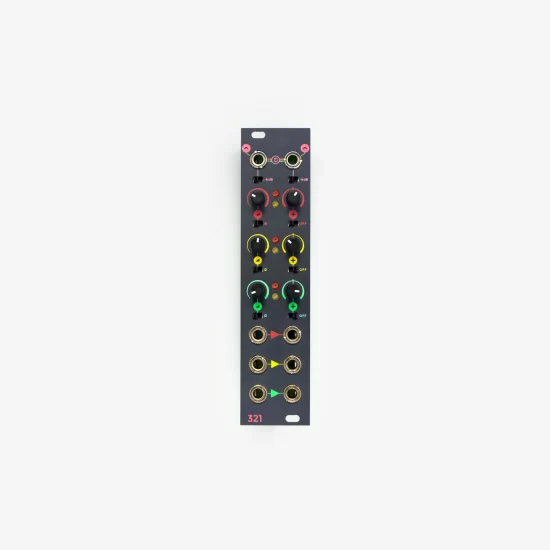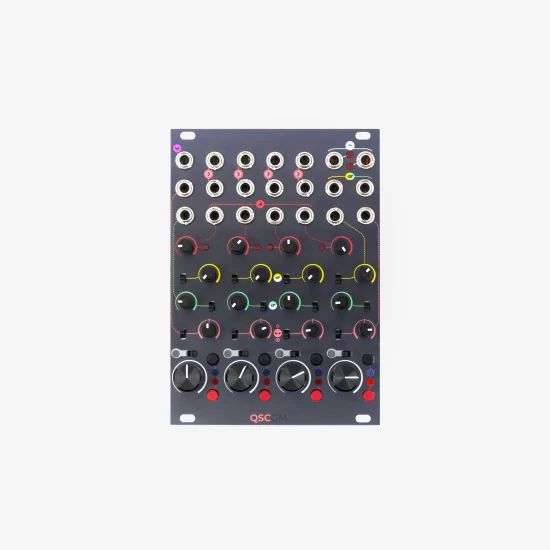Sapèl
SAPÈL
Tamed Random Source
sapèl / saˈpɛːl / s.m. [dialect from the northern area of Modena – Italy, uncertain etymology: probably from vulgar Latin sappa, ‘hoe’, meaning ‘roughly hoed’] – ‘mess’, ‘muddle’, ‘chaos’.
OR:
440,00 € + VAT
Out of stock
Want to be notified when this product is back in stock?
Description
SAPÈL is an analog generator of random control voltages for Eurorack modular systems. It generates a wide variety of random values to add dynamics to your patches. Such values are sampled on analog thermal noise to guarantee the truest random generation.
Its main section is composed of two identical clusters of four Sample and Hold circuits each (yellow and green), generating as many different random values simultaneously.
Three of the four S&H circuits in each cluster provide stepped random voltages: two are quantized (in “notes”), and one is unquantized; the last S&H circuit features an integrator to generate a fluctuating stream of random voltages.
The three stepped voltage generators are synced, which means they will output three different values simultaneously. The yellow and green generators have two independent internal clocks, which can be replaced with an external one, or temporarily overridden via an external signal or the manual button.
Regardless of the clock used, each S&H cluster features two clock outputs: one that mirrors the input clock and another that provides a random clock behavior.
On the other hand, the fluctuating voltage generator is independent and has its own potentiometer to define its rate.
Each of the two S&H clusters samples its values from analog noise, thus providing a “true” and completely unpredictable randomness.
The second section of SAPÈL features four analog noise outputs derived from the analog noise used to sample random values.
Key Features
SAPÈL has two analog sample-and-hold circuits that generate eight random voltages simultaneously from analog thermal noise.
Each circuit has its own internal clock, which you can override with external trigs.
You can trig the four random generators in four ways:
- With the internal clock;
- With external trigs (overriding the internal clock);
- With external signals (without overriding the internal clock);
- With the built-in button.
You can also modulate the internal clock’s rate externally.
Each random generator has a clock output and a Random clock output.
In Less Than mode, the Random clock outputs just some clocks here and there.
In More Than mode, it outputs more random clocks than the main one.
In both cases, the Global Rate of Change defines the random clock density.
The 2ⁿ circuit generates random voltages precisely tuned to 12-EDO semitones.
The n+1 circuit outputs random voltages quantized to octaves.
Both circuits’ knobs define the n value, from 1 to 6: in this way, the 2ⁿ section can output 2, 4, 8, 16, 32, or 64 semitones, while the n+1 circuit can output 2, 3, 4, 5, 6, or 7 octaves.
We, of course, drew from the classic Buchla 266 but redesigned the circuit from scratch to provide a more even and “musical” value distribution.
This circuit generates a smooth, fluctuating random voltage.
It is the only random output that is not linked to the clock. It is a separate S&H circuit that integrates its values.
Its knob defines the fluctuation rate, from subtle, LFO-like frequencies to a sort of audio noise.
The Fluctuating Random knob also defines the random clock probability (Global Rate of Change).
Each generator has a classic, unquantized S&H circuit. Its wide range and its all-analog generation guarantee true noise: you won’t get two similar voltages in a row for a while!
SAPÈL also has four analog noise outputs that provide Blue, White, Pink, and Red noise.
Hissing cymbals, roaring thunders, and windy seashores are at your fingertips.
This circuit allows you to control the average random voltage magnitude. From left to right, it will make the S&H circuits generate more low, mid, or high values, respectively.
On each section, you can route the Probability Distribution to each of the four random noise generators independently.
Learn
Learn
Learn
Additional information
| Weight | 0,366 kg |
|---|---|
| Dimensions | 15,6 × 11,7 × 6 cm |
Specs
Size | 18 HP |
Depth | 38 mm |
Current draw | 270 mA @ +12 V 170 mA @ -12 V |
Recommended warmup time | 30 min |
CV input impedance | >90 KΩ |
Clock input impedance | >90 KΩ (on positive pulses) ~30 KΩ (clamping negative pulses) |
Built-in clock frequency (1) | ~0.1–60 Hz |
Quantized Random Voltages tolerance | <1 % +/-10 mV |
Clock output (period) | ~2 ms |
Clock output (amplitude) | ~9 V |
Sampling glitch | <400 µs |
Blue noise output level | 10 dBU RMS |
White noise output level | 10 dBU RMS |
Pink noise output level | 7 dBU RMS |
Red noise output level | 4 dBU RMS |
Noise output global tolerance | +/-2 dB |
(1) Lower frequencies (i.e., slower clocks) may be achieved with a negative CV used as modulation.
FAQ
A. Use
Our modules are packed with high-quality components that demand a proper power supply and can get sensibly warm.
That is its normal temperature and we can guarantee their performance.
If you experience abnormal behaviors with SAPÈL, check your case’s power supply and your system’s overall power consumption. For example, we experienced that SAPÈL sometimes has trouble working in a system close to its maximum Ampère output.
To solve this issue, try staying below 80% of the full amperage or switch to a more powerful PSU.
B. Design
We have two main kinds of capacitors.
The first one is necessary to AC-couple the audio signal: they prevent any unwanted DC offset, and they offer protection against wrong connections. For this reason, you can patch nearly every input to every output, and the worst thing that can happen is some pops or some silence.
The second one is power filters to guarantee a cleaner current flow across the case. They might sound a bit over the top, but we must remember that a Eurorack system is not something that comes straight out of the factory. Instead, every Eurorack setup is unique and may change according to the musician’s need. For this reason, we want to add as much protection as we can, both to avoid issues with our modules and to ensure that even the other modules behave correctly. We use a wide mix of capacitors in our modules: ceramic, electrolytic, tantalum, and multilayer. They can be assembled thru-hole or SMD, according to what gives the best balance between result and space. For example, all the electrolytic capacitors are mounted thru-hole because they perform better according to our tests.
However, the capacitors have zero impact on the power draw, on which you can read in this other FAQ.
Power draw should always be related to what a module does.
Generally speaking, there are modules like SAPÈL that undoubtedly consume more than other random generators. However, SAPÈL is a double module, so a fair comparison would be between it and a pair of similar modules. The same can be said for FUMANA, the most power-demanding filter bank. However, it is also the only Eurorack filter bank with 32 analog bandpass filters, half of which have a 48 dB/oct slope. So, also in this case, a fairer comparison would be between FUMANA and TWO other 16-band filter banks, which leads to similar power consumptions.
More in detail, we engineer our modules to be safe to use. To protect both the modules and the rest of the case, we add a proper buffering stage to every input and output: even if a single buffer doesn’t draw that much power, all the ins and outs piled together can significantly impact the final power draw.
C. Shop
Yes! We opened our online store in October 2022. Check out the full catalog!
Our resellers receive our modules exclusively through our distributor, so we do not have access to the individual shops’ orders or stocks.
We restock every module at least once over a year: we focus on a module’s batch at a time, then we move on to the next one, and so on.
If you want an estimated delivery time for a specific module, drop us a line! We’ll be happy to answer you.
You may also like…
-
Out of stock
Fumana
Out of stock. Join the waitlist to be notified when this product becomes available.

















